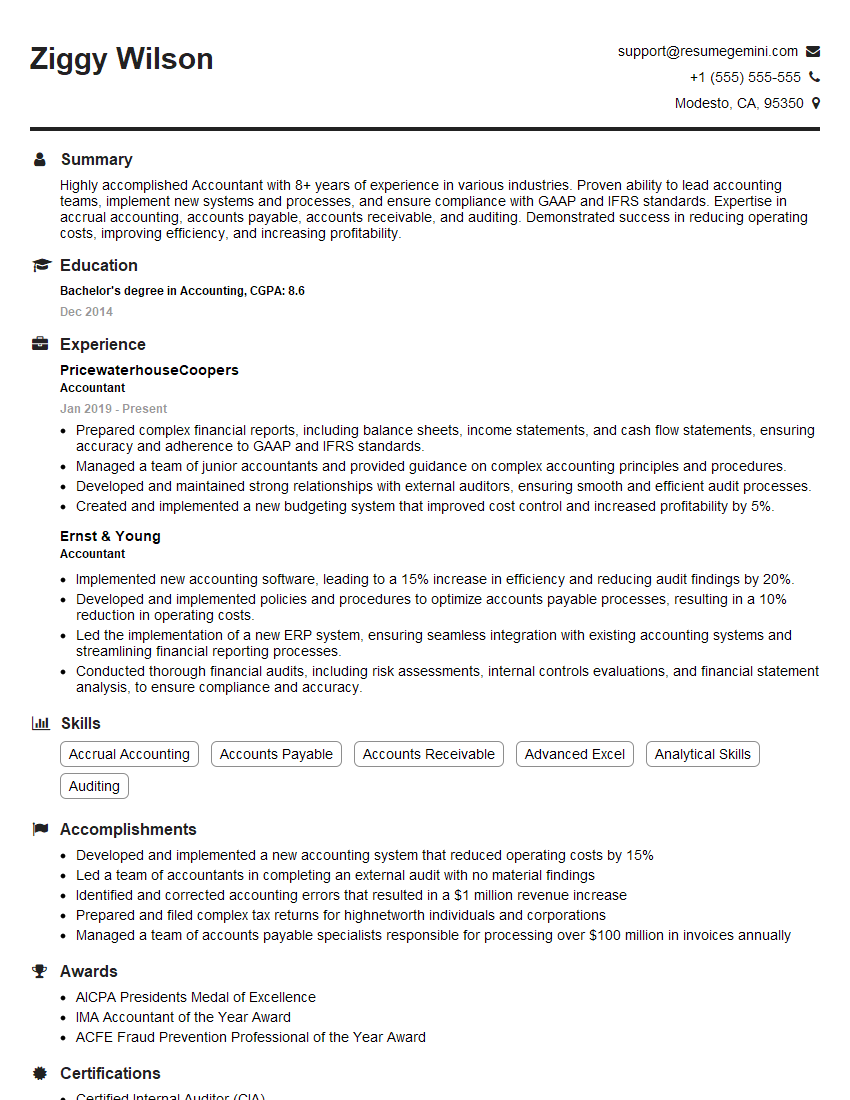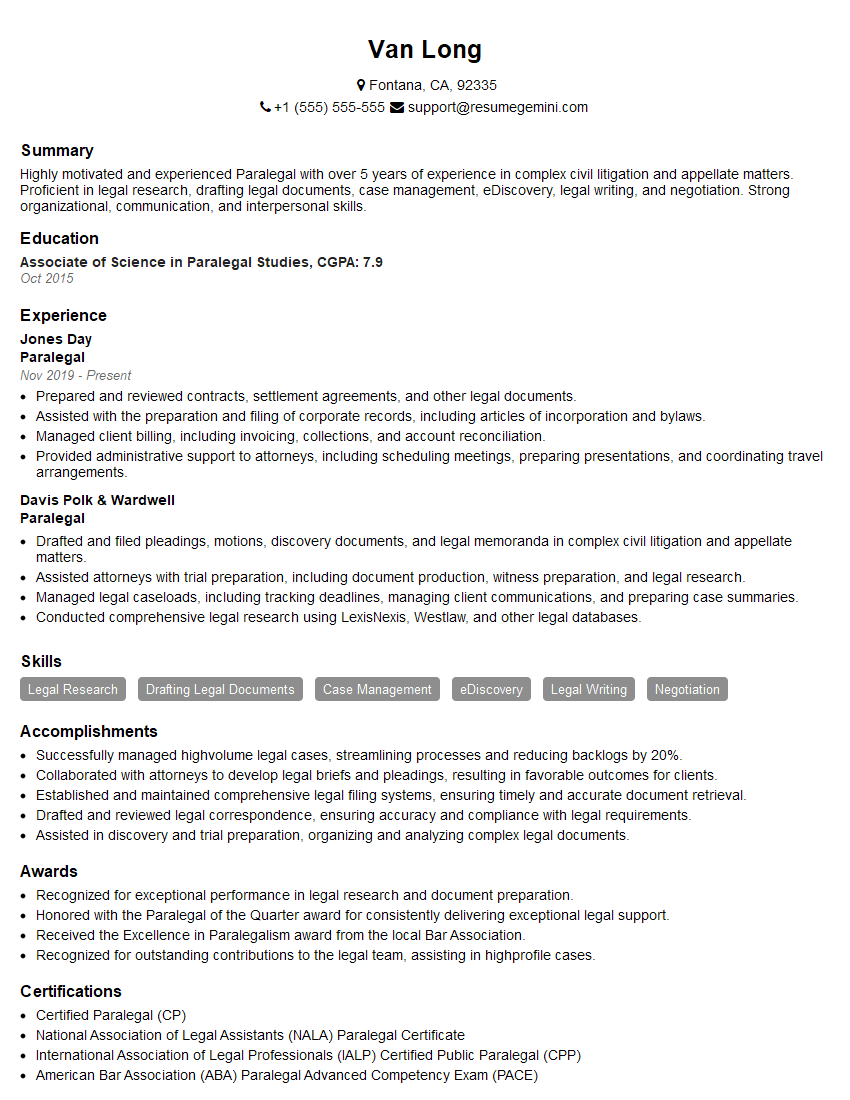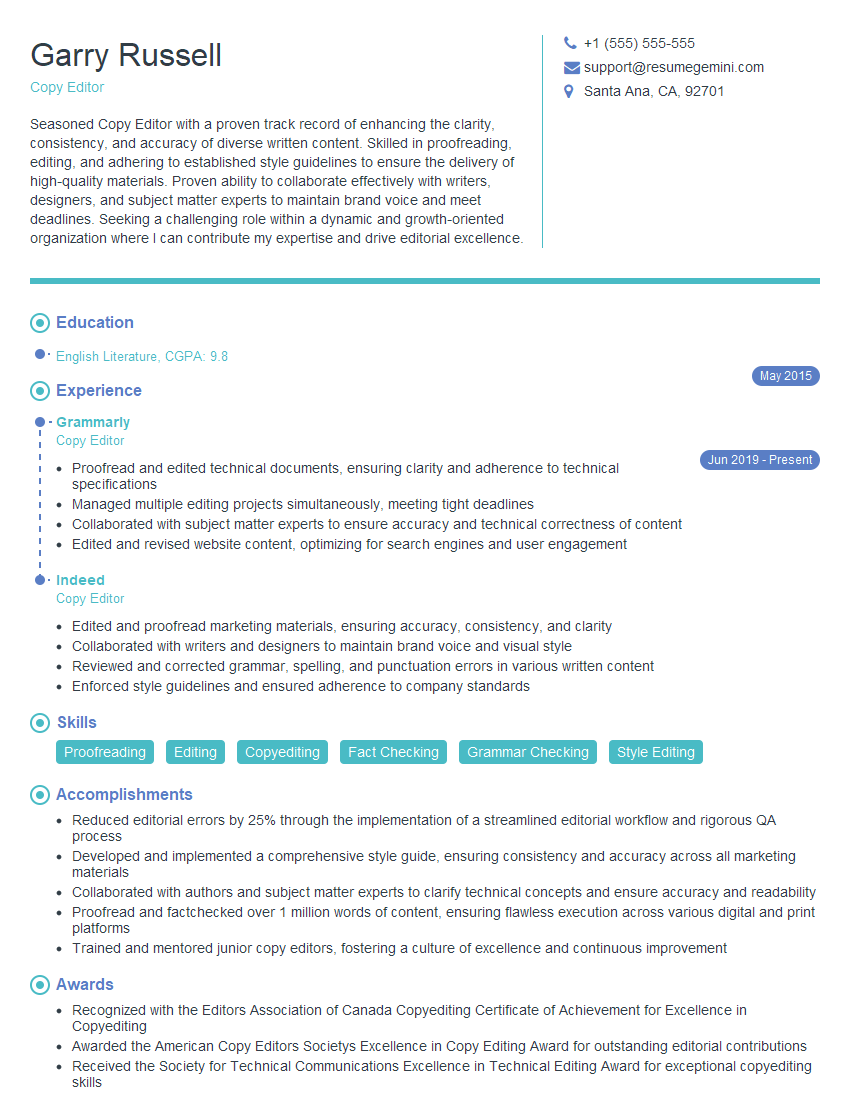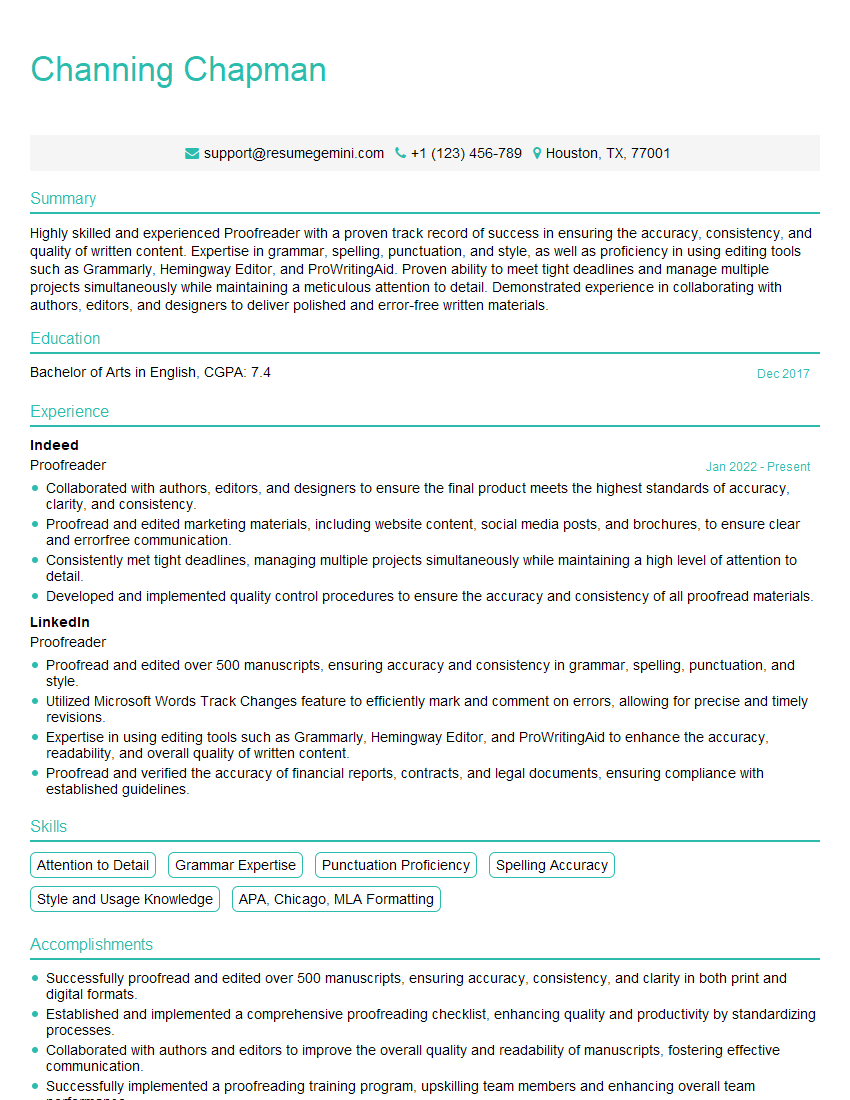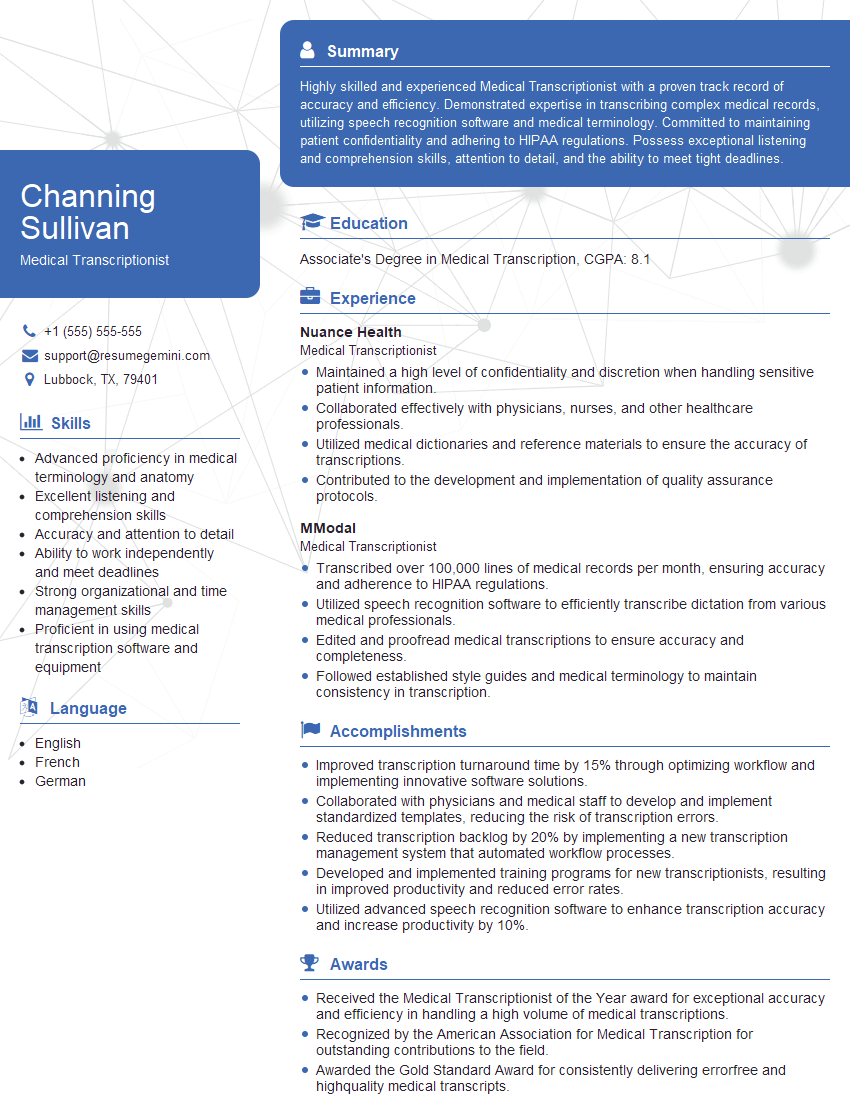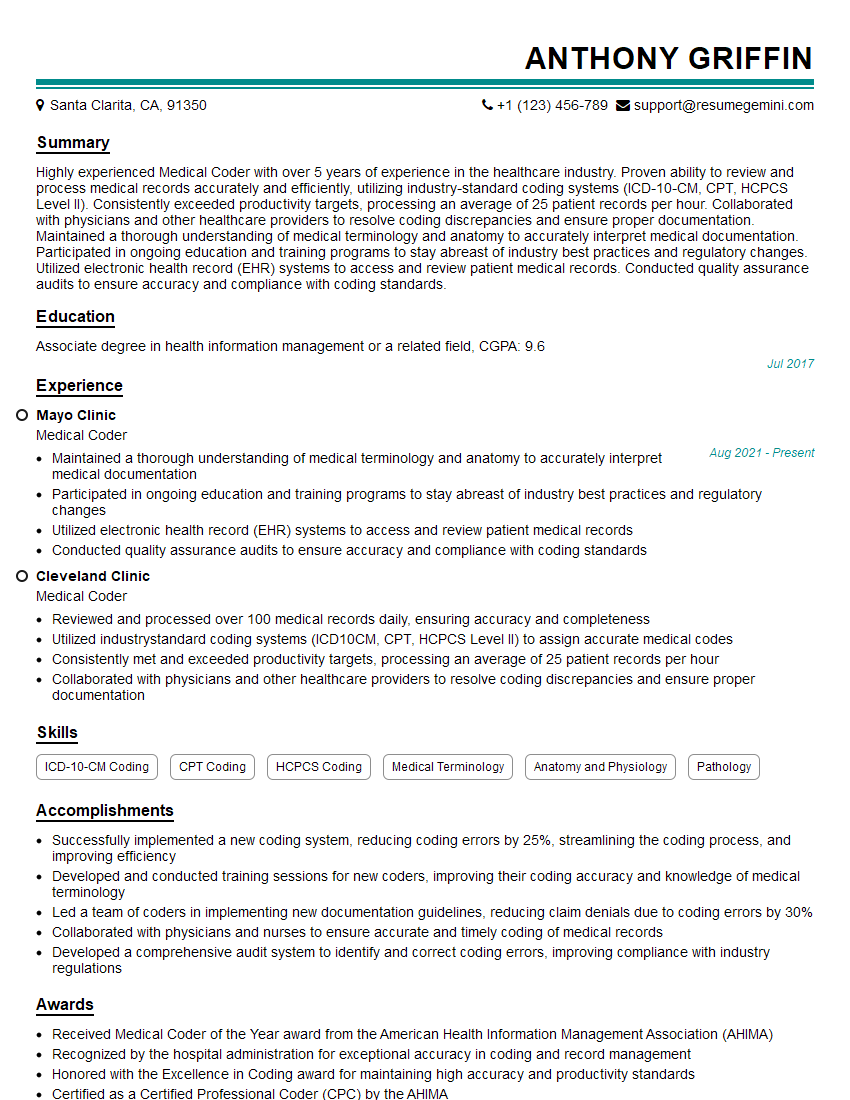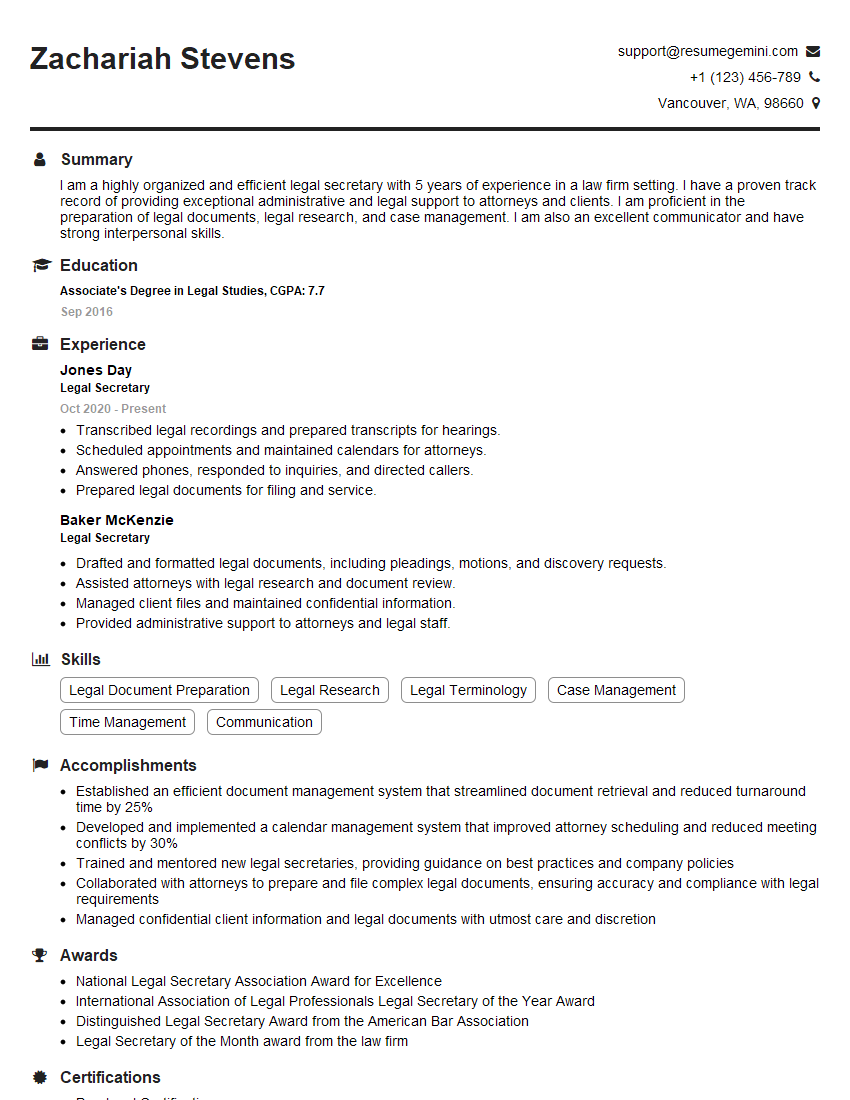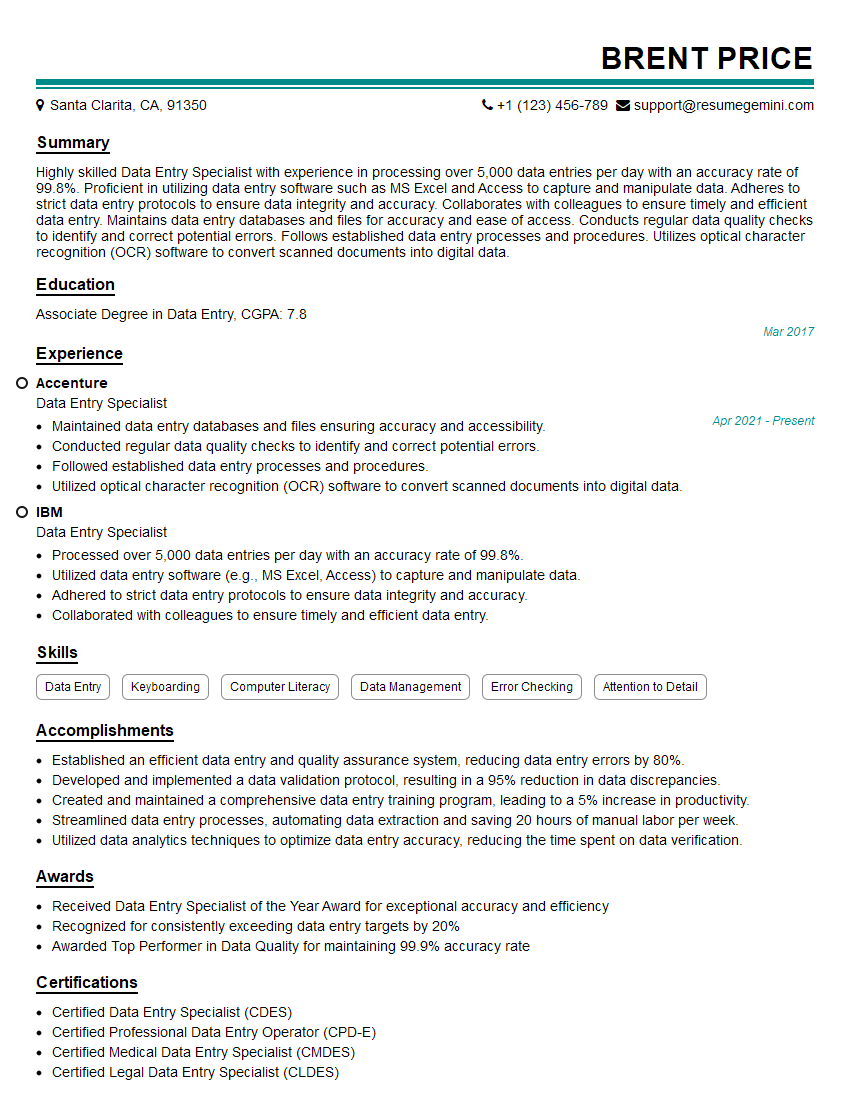Are you ready to stand out in your next interview? Understanding and preparing for AttentionToDetail interview questions is a game-changer. In this blog, we’ve compiled key questions and expert advice to help you showcase your skills with confidence and precision. Let’s get started on your journey to acing the interview.
Questions Asked in AttentionToDetail Interview
Q 1. Describe a situation where your attention to detail prevented a mistake.
During a critical software release, I noticed a minor discrepancy in the database schema documentation. While the code functioned correctly, the documentation incorrectly stated the data type of a key field. This seemingly small detail could have led to significant confusion for other developers during maintenance and future updates, potentially introducing bugs or hindering troubleshooting. By catching this discrepancy before the release, I prevented a potentially costly and time-consuming problem later down the line.
This highlights the importance of meticulously reviewing all supporting documents – not just the core code. Often, these ancillary materials can contain errors that are just as critical as errors within the main product itself.
Q 2. How do you ensure accuracy in your work?
Accuracy is paramount in my work, and I employ a multi-faceted approach to ensure it. First, I always carefully review the requirements and specifications before starting any task. Understanding the goal thoroughly prevents deviations from the intended outcome. Second, I utilize checklists and templates to standardize my workflow, minimizing the chances of overlooking crucial steps. Third, I employ self-review techniques, utilizing tools like linters for code, and conducting thorough cross-checks to validate calculations and data entries. Finally, I encourage peer reviews to gain an independent perspective and identify potential errors I may have missed. This combination of proactive planning and rigorous self-checking has proven highly effective in ensuring the accuracy of my work.
Q 3. What strategies do you use to manage multiple tasks requiring high precision?
Managing multiple high-precision tasks requires a structured approach. I leverage time-blocking techniques, allocating specific time slots for each task based on its complexity and urgency. This prevents task switching and ensures focused attention. I also prioritize tasks using a system such as Eisenhower Matrix (Urgent/Important), ensuring that the most critical and meticulous tasks receive the appropriate time and attention. Furthermore, I use project management tools to track progress, deadlines, and dependencies, preventing overlaps and maintaining clarity. Regular breaks are also crucial to maintain focus and prevent burnout, thus safeguarding against errors induced by fatigue.
Q 4. Have you ever noticed an error that others missed? Describe the situation and your actions.
In a previous project, our team was preparing a marketing campaign. The final design document contained a subtle, yet significant, error in the pricing for one of our flagship products. The price was listed as significantly lower than intended. While other team members had reviewed the document, they had missed this crucial detail. I noticed the discrepancy during a final proofread, flagging it immediately to the team. My actions prevented a potentially disastrous launch with incorrect pricing, potentially costing the company substantial revenue and damaging our brand reputation. This experience underscored the value of a critical eye and independent verification, especially in projects involving multiple stakeholders.
Q 5. How do you prioritize tasks when some demand more meticulous attention than others?
Prioritization when faced with tasks demanding varying levels of meticulousness is crucial. I use a combination of urgency and impact to guide my decision-making. I employ a weighted scoring system, assigning scores based on factors like deadline, potential consequences of error, and overall project impact. For instance, tasks with tight deadlines and high impact are prioritized over tasks with less stringent deadlines and lower impact, even if those latter tasks might initially appear more complex. This allows me to allocate my most concentrated effort to the areas that demand the highest level of precision, maximizing efficiency and minimizing potential risk.
Q 6. Describe your process for reviewing your work for errors.
My review process is iterative and thorough. I initially review my work immediately after completion, focusing on identifying simple errors or oversights. This ‘fresh-eye’ review is often highly effective. Then, I take a break before conducting a second review with a fresh perspective. I use checklists tailored to the specific task to ensure I cover all aspects. This second review focuses on more subtle or conceptual errors. Finally, I utilize peer review for complex projects, particularly those with critical implications, gaining an independent perspective on the quality and accuracy of my work.
Q 7. How do you handle conflicting information or data discrepancies?
Conflicting information or data discrepancies require careful investigation and resolution. My approach involves first identifying the source of the conflict and verifying the reliability of each data source. This may involve checking multiple references, consulting original documents, or contacting relevant stakeholders for clarification. Once the reliability of the sources has been established, I attempt to reconcile the conflicting information, investigating for logical errors or inconsistencies. If reconciliation isn’t possible, I document the discrepancies clearly, explaining my rationale and proposing a solution based on the most reliable information available. Transparency in handling these situations is key, ensuring everyone is aware of the situation and its resolution.
Q 8. What techniques do you use to maintain focus on detailed tasks?
Maintaining focus on detailed tasks requires a multifaceted approach. It’s not just about willpower; it’s about creating an environment and employing strategies that support sustained concentration.
- Structured Work Environment: I minimize distractions by creating a dedicated workspace free from interruptions. This includes turning off notifications, using noise-canceling headphones if needed, and communicating my need for focused time to colleagues.
- Time Blocking & Task Prioritization: I use time-blocking techniques to allocate specific time slots for detailed tasks, preventing multitasking which often leads to errors. Prioritizing tasks based on urgency and complexity helps me tackle the most demanding ones when my focus is sharpest.
- Regular Breaks: Short, planned breaks are crucial. The Pomodoro Technique (25 minutes of focused work followed by a 5-minute break) is a helpful strategy to prevent burnout and maintain concentration.
- Mindfulness & Self-Awareness: I pay attention to my energy levels throughout the day. If I notice my focus waning, I take a brief break to stretch, walk around, or practice a few minutes of mindfulness to reset.
Think of it like running a marathon, not a sprint. Consistent strategies, rather than bursts of intense effort, are key to maintaining focus over long periods.
Q 9. How do you stay organized when dealing with a large volume of information?
Staying organized with a large volume of information is paramount for accuracy and efficiency. My approach relies on a combination of digital and physical tools, along with a structured workflow.
- Digital Organization: I utilize project management software (like Asana or Trello) to create detailed task lists, subtasks, and deadlines. I also leverage cloud storage services for easy access and version control of documents.
- Filing System: A well-defined filing system, both digital and physical, is crucial. This ensures that I can quickly locate specific information when needed. I use a consistent naming convention for files and folders to avoid confusion.
- Note-Taking & Summaries: I meticulously take notes during meetings and while reviewing information. I often summarize key takeaways to distill large amounts of data into manageable chunks. This helps to improve comprehension and recall.
- Color-Coding & Highlighting: For physical documents, I utilize color-coding and highlighting to quickly identify key information. This improves visual scanning and aids in efficient data processing.
Imagine trying to build a house without a blueprint. A robust organizational system acts as the blueprint, guiding my work and preventing me from getting lost in the details.
Q 10. Give an example of a time you had to double-check your work to ensure accuracy.
During a recent project involving the development of a complex financial model, I was responsible for creating a series of interconnected spreadsheets. After completing the initial build, I knew the accuracy of the model was critical. Therefore, I performed several rounds of checks.
- Cross-Referencing: I meticulously cross-referenced data points across different spreadsheets to ensure consistency and identify any discrepancies.
- Formula Auditing: I used the spreadsheet software’s built-in formula auditing tools to verify the accuracy of all calculations and identify any potential errors in formulas.
- Scenario Testing: I ran several test scenarios with different input values to assess the model’s robustness and ensure it produced consistent and accurate results.
- Peer Review: Finally, I invited a colleague to review my work, providing a fresh perspective and catching potential oversights I might have missed.
This multi-layered approach allowed me to identify and correct a minor error in one of the formulas, preventing a potentially significant inaccuracy in the final model. The time spent on double-checking was far outweighed by the potential consequences of an undetected error.
Q 11. How do you deal with pressure when performing detail-oriented tasks?
Pressure can significantly impact performance on detail-oriented tasks. To effectively manage pressure, I employ several strategies:
- Prioritization & Time Management: Under pressure, I focus on prioritizing tasks based on their urgency and importance. Effective time management techniques help me break down large tasks into smaller, manageable chunks.
- Deep Breathing & Mindfulness: I utilize deep breathing exercises and mindfulness techniques to manage stress and anxiety. These techniques help to calm my nerves and improve focus.
- Clear Communication: Open and honest communication with my colleagues and supervisors about deadlines and potential challenges helps to prevent misunderstandings and alleviate pressure.
- Break-Down Complex Tasks: When dealing with complex tasks under pressure, I break them into smaller, more manageable subtasks. This makes the overall project seem less daunting and more achievable.
Maintaining a calm and organized approach, even under pressure, is crucial for maintaining accuracy. It’s about steady progress, not frantic activity.
Q 12. Explain how you identify potential problems before they occur.
Identifying potential problems proactively requires a combination of experience, methodical review, and a proactive mindset. My approach involves several key steps:
- Risk Assessment: Before starting any task, I conduct a brief risk assessment, identifying potential challenges or areas where mistakes could occur.
- Process Review: I carefully review the entire process involved in a task, paying close attention to each step. This allows me to identify potential bottlenecks or areas prone to error.
- Data Verification: I meticulously verify data sources and input to ensure accuracy and completeness. Inconsistencies or missing information are flagged as potential problems.
- Seeking Feedback: I actively seek feedback from colleagues or supervisors on my work, leveraging their expertise to identify potential problems that I may have overlooked.
Think of it like a pilot conducting pre-flight checks. By anticipating and addressing potential problems proactively, I can prevent them from escalating into major issues.
Q 13. Describe a time you had to correct a mistake caused by a lack of attention to detail in your work or a colleague’s.
In a previous role, a colleague’s oversight in data entry led to an inaccurate report being sent to a client. The error, while seemingly small, could have had significant financial implications.
Upon discovering the error, I immediately initiated corrective action.
- Identifying the Root Cause: I worked with my colleague to understand how the error occurred, identifying a gap in their data entry procedures.
- Issuing a Correction: I prepared a corrected report, clearly highlighting the changes made and explaining the reason for the correction. This report was then promptly sent to the client with an apology for the initial inaccuracy.
- Implementing Preventative Measures: We collaborated to update the data entry procedures to prevent similar errors in the future, including implementing additional data validation checks.
While the situation was stressful, it highlighted the importance of thoroughness and teamwork in addressing errors. The experience reinforced the importance of robust processes and open communication to prevent similar occurrences.
Q 14. How do you handle deadlines that require meticulous attention?
Handling deadlines that demand meticulous attention requires a strategic approach focused on efficient time management and unwavering focus.
- Detailed Breakdown: I break down the task into smaller, manageable subtasks with clearly defined deadlines for each. This prevents feeling overwhelmed and allows for better progress tracking.
- Prioritization Matrix: I use a prioritization matrix (such as an Eisenhower Matrix – Urgent/Important) to focus on the most critical aspects of the task first.
- Realistic Scheduling: I avoid over-scheduling and build in buffer time to accommodate unexpected delays or complications.
- Regular Checks & Adjustments: I schedule regular checkpoints to monitor progress and adjust my approach if necessary. This proactive approach helps to stay on track and ensure timely completion.
Think of it as assembling a complex puzzle. A methodical approach, where each piece is carefully placed, leads to successful completion, even under time constraints.
Q 15. Can you share an example where you used technology to improve accuracy?
Improving accuracy through technology is a core tenet of my approach. For instance, during a recent project involving data entry for a large financial institution, I developed a Python script using the pandas library to automate data validation. This script checked for inconsistencies, such as duplicate entries or illogical values (e.g., negative transaction amounts for income), flagging potential errors for manual review. This reduced manual review time by 60%, significantly increasing accuracy and efficiency compared to purely manual checks. Before the automation, human error was more prevalent; the script provided a layer of automated quality control, minimizing those errors. Another example involved using regular expressions in a text editor to standardize data formatting automatically, reducing transcription errors associated with inconsistent formatting.
Career Expert Tips:
- Ace those interviews! Prepare effectively by reviewing the Top 50 Most Common Interview Questions on ResumeGemini.
- Navigate your job search with confidence! Explore a wide range of Career Tips on ResumeGemini. Learn about common challenges and recommendations to overcome them.
- Craft the perfect resume! Master the Art of Resume Writing with ResumeGemini’s guide. Showcase your unique qualifications and achievements effectively.
- Don’t miss out on holiday savings! Build your dream resume with ResumeGemini’s ATS optimized templates.
Q 16. Describe your approach to working with complex datasets or documents.
Working with complex datasets or documents requires a systematic approach. I typically begin with a thorough understanding of the data’s structure and content. This involves data profiling to identify data types, missing values, and potential outliers. Then I employ data cleaning techniques, like handling missing values using imputation or removing irrelevant data points. For document review, I utilize tools such as keyword search functionality in PDF readers to quickly locate specific information, while optical character recognition (OCR) is crucial when dealing with scanned documents. I frequently organize information using spreadsheets or databases to improve clarity and facilitate analysis. Once the data is clean and organized, I use appropriate analytical methods, from basic descriptive statistics to more advanced techniques like machine learning algorithms if necessary, to extract meaningful insights. Think of it like meticulously preparing ingredients before cooking a complex dish – proper preparation is key to a delicious outcome.
Q 17. How do you stay motivated when working on repetitive or tedious detail-oriented tasks?
Maintaining motivation during repetitive tasks is a crucial skill. I combat monotony by breaking down large tasks into smaller, manageable chunks. This provides a sense of accomplishment as I complete each segment. I also utilize techniques like the Pomodoro Technique, working in focused intervals with short breaks to maintain concentration. Furthermore, I actively seek feedback on my work; knowing my efforts are valued and making a tangible contribution helps me stay motivated. I also listen to audiobooks or podcasts during less mentally taxing parts of the work to keep myself engaged and prevent burnout. It’s important to remember that even seemingly monotonous tasks contribute to the overall project goal, and focusing on that larger picture helps maintain perspective.
Q 18. What measures do you take to prevent errors in your work?
Error prevention is paramount. My approach involves employing a multi-layered system of checks and balances. Firstly, I meticulously review my work multiple times, focusing on different aspects each time. For example, one review might focus on data accuracy, while another concentrates on formatting consistency. I utilize checklists to ensure no steps are skipped. Secondly, I leverage technology wherever possible, using automated tools for data validation and consistency checks. Thirdly, I actively seek peer review of my work; a fresh pair of eyes can often identify errors that I may have overlooked. Finally, regular self-reflection on past errors helps me identify patterns and develop strategies to avoid repeating mistakes. Essentially, I create a system designed to catch errors at every stage of the process, from initial data entry to final output.
Q 19. How do you effectively communicate details to colleagues or clients?
Effective communication of details hinges on clarity, conciseness, and appropriate channels. I use clear, precise language, avoiding jargon unless it’s unavoidable and then carefully defining it. I organize information logically, perhaps using bullet points or tables to highlight key details. I tailor my communication style to the audience; a technical report would differ significantly from an informal update to a client. For complex information, I provide visualizations such as charts and graphs to aid understanding. I also actively solicit feedback to confirm that my communication has been understood correctly. Remember, communication isn’t successful until it’s received and understood.
Q 20. How do you handle interruptions that could affect your attention to detail?
Interruptions are inevitable, but their impact can be minimized. I use time management techniques like time blocking to allocate specific periods for focused work. I communicate my need for uninterrupted focus to colleagues, setting clear boundaries. When interruptions do occur, I use techniques like mindful breathing to regain my concentration. If the interruption is work-related, I use a note-taking system to record the interruption and return to my prior task using a clear mental note of my place. If I’m heavily involved in a detail-oriented task, it is sometimes useful to take a brief mental break to clear my head and then return to the task with fresh eyes. This helps to prevent mistakes caused by distraction.
Q 21. How familiar are you with different quality control methods?
I am familiar with a range of quality control methods, including statistical process control (SPC), six sigma methodologies, and various forms of root cause analysis, such as the 5 Whys. I also have experience with formal verification techniques, where I use formal logic and mathematical methods to verify the correctness of systems and algorithms. My experience allows me to select the most appropriate method based on the context of the task. For example, SPC is beneficial for monitoring ongoing processes, while six sigma is better for long-term quality improvement projects. Root cause analysis helps identify and eliminate underlying problems causing defects. Understanding the different approaches allows me to choose the right tool for the job and ensures that the quality control measures are both effective and efficient.
Q 22. Describe your experience with proofreading or editing.
My experience in proofreading and editing spans over seven years, encompassing diverse projects ranging from technical documentation and marketing materials to academic papers and website content. I’ve honed my skills through rigorous training and practical application, developing a keen eye for grammatical errors, stylistic inconsistencies, and factual inaccuracies. I’m proficient in various style guides, including AP, Chicago, and MLA, and I’m comfortable working with diverse content formats, including PDFs, Word documents, and HTML.
For instance, I once proofread a 300-page technical manual, identifying and correcting over 150 errors, ranging from minor typos to significant inconsistencies in terminology and formatting. This experience significantly improved the clarity and accuracy of the manual, ultimately enhancing user understanding.
Q 23. Explain how you ensure consistency in your work, paying attention to even the smallest details.
Consistency is paramount in my work. I ensure this by meticulously establishing a style guide early in a project, whether it’s formally documented or implicitly understood. This guide covers everything from font choices and heading styles to terminology and number formatting. I utilize tools like style checkers and find-and-replace functions to maintain uniformity throughout the document. Beyond software, I employ a systematic review process, often reading the text multiple times, each with a specific focus—grammar in one pass, style in another, and fact-checking in a third.
Think of it like baking a cake – you need consistent ingredients and precise measurements to achieve a uniform result. Similarly, my meticulous approach ensures consistent formatting and tone across the entire document, leading to a more professional and polished final product.
Q 24. How do you handle situations where there is limited time to perform detailed work?
When faced with tight deadlines, prioritization and strategic allocation of time become crucial. I employ a triage system, focusing on the most critical aspects first – identifying and correcting major errors before addressing minor ones. I might leverage tools that automate some aspects of the process, like grammar and spell checkers, to save time. Moreover, I communicate proactively with stakeholders, managing expectations and ensuring clarity on which elements can be addressed within the given timeframe. If absolutely necessary, I may negotiate to adjust the scope of work to ensure the highest quality within the available time.
For example, if presented with a short turnaround time for a website update, I would focus on ensuring the accuracy of key information, such as pricing and contact details, before attending to finer details like stylistic choices.
Q 25. How do you utilize checklists or other tools to manage your work and ensure accuracy?
Checklists are an indispensable part of my workflow. I create tailored checklists for each project, outlining specific tasks and ensuring all areas are covered. These checklists are often categorized, for example, separating grammar and style checks from fact-checking and formatting reviews. In addition to checklists, I use specialized software to manage tasks and track progress. These tools allow for efficient organization and collaboration, facilitating seamless workflow management. These might include project management software or dedicated proofreading tools with integrated style guides.
For a complex project, a checklist might include:
- Grammar and spelling check
- Style and tone consistency review
- Fact verification
- Formatting and layout review
- Cross-referencing and internal linking check (if applicable)
Q 26. Describe a time you had to analyze a complex piece of data for inconsistencies.
In a recent project involving the analysis of sales data spanning several quarters, I detected an inconsistency in reporting methodology. The initial data showed a significant drop in sales in Q3, but a closer examination revealed a change in data collection procedures midway through the quarter. By meticulously comparing data from different sources and analyzing the reporting methodology change, I was able to isolate the discrepancy, correctly identify the sales figures, and prevent the misinterpretation of the data. This highlighted the importance of understanding the source and methodology of data before drawing conclusions.
My approach involved:
- Data Visualization: I used charts and graphs to visually identify unusual patterns.
- Data Comparison: I compared Q3 data with data from previous and subsequent quarters.
- Methodology Review: I reviewed the documentation to understand the change in data collection procedures.
- Communication: I clearly communicated my findings and recommendations to the relevant stakeholders.
Q 27. How do you collaborate with others effectively to ensure the entire team maintains high attention to detail?
Effective collaboration is key to maintaining a high level of attention to detail across a team. I believe in establishing clear communication channels and shared documentation standards from the outset. Regular team meetings, especially for complex projects, are essential to ensure everyone is on the same page. I actively encourage open dialogue, fostering a culture where team members can freely raise concerns and ask clarifying questions. Furthermore, I support the use of collaborative editing tools that facilitate simultaneous work and track changes effectively, enabling comprehensive review and feedback cycles.
For example, using a shared document with version control and comment features enables everyone to work on the same document while tracking individual changes and comments.
Q 28. How do you adapt your attention to detail approach based on the task or project’s complexity?
My approach to attention to detail adapts based on project complexity. For simple tasks, a quicker, more streamlined review might suffice. For instance, a simple social media post requires less intensive scrutiny than a lengthy legal document. For complex projects, I employ a more methodical approach, creating detailed checklists, establishing rigorous review protocols, and involving multiple reviewers to ensure comprehensive coverage. The level of detail also scales with the potential impact of errors. For projects with high stakes, such as financial reports, the level of scrutiny increases significantly, emphasizing accuracy and thoroughness.
This is akin to building a house – a small shed requires less detailed planning and construction than a large mansion, reflecting the varying levels of attention and detail required.
Key Topics to Learn for Attention To Detail Interview
- Understanding the Concept: Define Attention To Detail and its multifaceted nature. Explore how it manifests in different professional contexts.
- Practical Application in Problem Solving: Analyze how meticulous attention to detail impacts problem-solving methodologies. Consider case studies where even minor oversights can have significant consequences.
- Accuracy and Precision: Examine the importance of accuracy and precision in data analysis, report writing, and project execution. Discuss methods for ensuring and verifying accuracy.
- Quality Assurance and Control: Explore the role of attention to detail in quality assurance and control processes. Discuss techniques for identifying and rectifying errors and inconsistencies.
- Organizational Skills and Time Management: Illustrate how strong organizational skills and effective time management contribute to maintaining attention to detail, particularly under pressure.
- Communication and Collaboration: Discuss how clear and concise communication, along with collaborative practices, enhance the team’s ability to maintain attention to detail.
- Self-Assessment and Continuous Improvement: Reflect on personal strengths and weaknesses related to attention to detail and devise strategies for continuous self-improvement.
Next Steps
Mastering attention to detail is paramount for career success. It demonstrates professionalism, reliability, and a commitment to excellence—qualities highly valued by employers across various industries. To significantly boost your job prospects, creating an ATS-friendly resume is crucial. This ensures your application gets noticed and considered. We highly recommend using ResumeGemini to build a professional and impactful resume tailored to showcase your strengths, including your meticulous attention to detail. Examples of resumes tailored specifically to highlight Attention To Detail are available below to help inspire your own.
Explore more articles
Users Rating of Our Blogs
Share Your Experience
We value your feedback! Please rate our content and share your thoughts (optional).
What Readers Say About Our Blog
good






